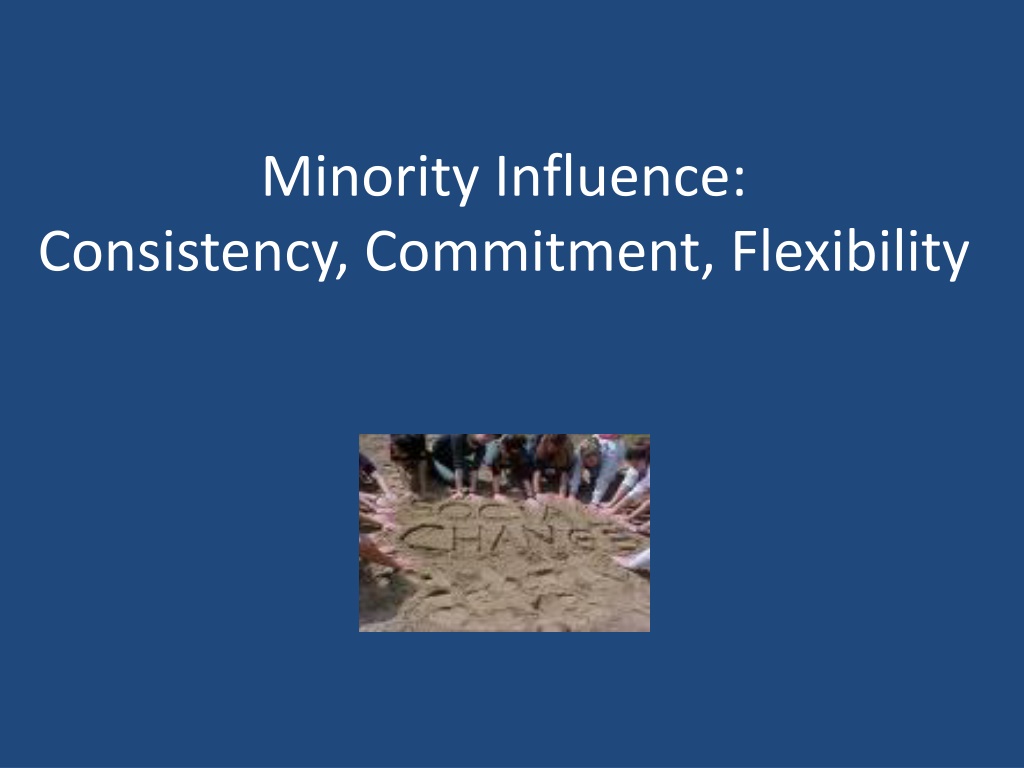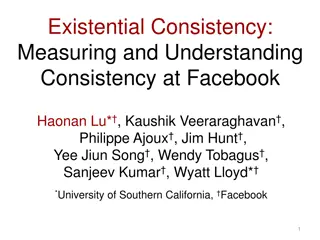Understanding Minority Influence: Consistency, Commitment, and Flexibility
Minority influence involves a small group of people persuading others to adopt their beliefs, attitudes, or behaviors, leading to internalization and social change. Consistency plays a vital role in exerting influence, as it encourages others to rethink their own views. Commitment, demonstrated by leaders sacrificing aspects of their lifestyle, is another key factor in driving social change through minority influence.
Download Presentation

Please find below an Image/Link to download the presentation.
The content on the website is provided AS IS for your information and personal use only. It may not be sold, licensed, or shared on other websites without obtaining consent from the author. Download presentation by click this link. If you encounter any issues during the download, it is possible that the publisher has removed the file from their server.
E N D
Presentation Transcript
Minority Influence: Consistency, Commitment, Flexibility
Minority Influence: A form of social influence in which a minority of people, or one individual, persuade others to adopt their beliefs, attitudes or behaviours. It leads to internalisation or conversion in which private attitudes are changed as well as public behaviours.
How minorities exert pressure and influence social change Consistency minorities exert most influence when consistent as it increases the amount of interest. This may be synchronic consistency (within a group) or diachronic consistency (over time). Consistency makes other people start to rethink their own views. Moscovici supports consistency as an important process in minority influence
Moscovici et al (1969) Aim: To assess whether a minority group could influence the majority in a perception task
Moscovici et al (1969) Procedure: Tested in groups of 6 Asked to judge the colour of 36 slides (All were BLUE) Two conditions: Consistent Minority & Inconsistent Minority Inconsistent Minority Consistent Minority 2 of 6 participants were confederates In all trials they judged the slides to be GREEN 2 of 6 participants were confederates In 24 trials they judged the slides to be GREEN. In 12 trails they judged the slides as BLUE A control group had no confederates
Findings: Consistent condition Inconsistent condition Genuine participants judged slides to be GREEN = 8.4% of trials Genuine participants judged slides to be GREEN = 1.3% of trials 32% of genuine participants judged a slide to be GREEN at least once Control Group judged slides as GREEN on 0.25% trials
How minorities exert pressure and influence social change Commitment - leaders of the minority/new movement need to be seen to be sacrificing some aspect of their lifestyle in order to demonstrate the importance of the ideals. Eg Ghandi, Mandella
How minorities exert pressure and influence social change Flexibility -minority groups must not appear to be unbending, rigid and dogmatic. Just repeating a message without reflecting on others beliefs is counterproductive. Minorities need to adapt their point of view if a reasonable and valid counter argument is raised. They need to balance between consistency and flexibility.
Nemeth (1986) groups of 3 participants and 1 confederate who had to decide how much compensation to pay the victim of a ski lift accident. When the confederate argued for a low amount and refused to change his position, he had no effect on the majority. When however he compromised a little and moved to offering a slightly higher amount, the majority changed their opinion to a lower amount. This shows how minorities need to be flexible to be persuasive while at the same time questions the importance of consistency.
Group poster activity You will be allocated one of the following examples of minorities who have changed the views of the majority or you could think of your own example: 1. Martin Luther King 2. Ghandi 3. Greenpeace 4. Nelson Mandella (and the ANC) 5. The suffragettes (including Emily Pankhurst) 6. The disability rights movement Which of the previous processes did they use? - Give examples What particular events happened over time?
The Role of Social Influence Processes in Social Change Social Influence is the process by which individuals and groups change each other s attitudes and behaviours Social change occurs when whole societies rather than just individuals adopt new attitudes, beliefs and ways of doing things eg gay rights, environmental issues.
The Role of Social Influence Processes in Social Change At a certain point the minority view becomes the norm and the majority then conform through compliance. For permanent social change to occur, people conform to the new viewpoint through identification involving a change in their belief systems. Social change is usually a slow gradual process of cryptoamnesia so that change occurs in a non-disruptive manner to society. Rapid change would cause conflict within society that could be harmful. A slow process allows new ideas to be carefully considered by the majority of society to ensure they are suitable.
Knowledge gained from conformity research: Some health campaigns use normative social influence by providing information on what others are doing eg preventing young people from taking up smoking by telling them that most other young people do not smoke. (+) Nolan et al (2008) hung messages on the front doors of houses in San Diego every week for one month: The message said most residents were trying to reduce their energy usage. In a control condition, residents had a different message asking them to save energy but made no reference to other people s behaviour. Significant decreases in usage were found in the first group showing social change can occur through normative social influence.
Knowledge gained from obedience research Milgram s research demonstrates the importance of disobedient role models. Additionally the process of gradual commitment can be used to create social change by making people obey a small instruction following which it gets harder to resist obeying instructions and people gradually move towards a new kind of behaviour.























